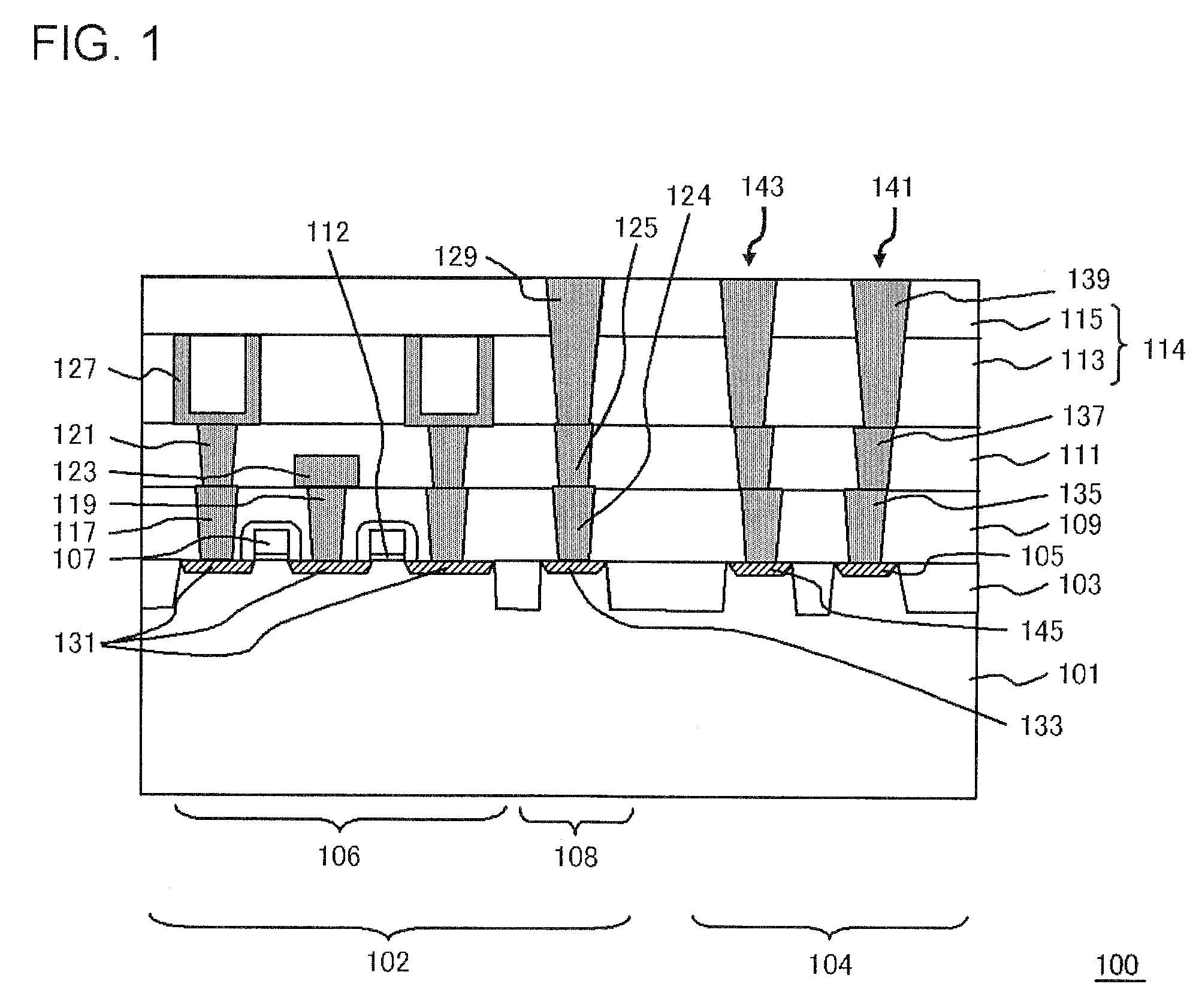Semiconductor device
a technology of semiconductor devices and semiconductors, applied in semiconductor devices, semiconductor/solid-state device details, electrical apparatus, etc., can solve the problems of inability to produce stable devices, short circuit between adjacent connecting plugs, and similar problems, and achieve effective inhibition, increase center-to-center distance, and improve the production yield of semiconductor devices
- Summary
- Abstract
- Description
- Claims
- Application Information
AI Technical Summary
Benefits of technology
Problems solved by technology
Method used
Image
Examples
first embodiment
[0035]FIG. 1 is a cross-sectional view, illustrating a configuration of a semiconductor device of the present embodiment.
[0036]A semiconductor device 100 shown in FIG. 1 includes a first interlayer insulating film 109 provided above a semiconductor substrate (silicon substrate 101), and a second interlayer insulating film 114 provided above the first interlayer insulating film 109 and having larger thickness than the first interlayer insulating film 109.
[0037]In the present embodiment, the second interlayer insulating film 114 is composed of a third interlayer insulating film 113 provided above the first interlayer insulating film 109 and a fourth interlayer insulating film 115 provided so as to be in contact with an upper side of the third interlayer insulating film 113, and the third interlayer insulating film 113 is thicker than the first interlayer insulating film 109. However, the second interlayer insulating film 114 is not limited to a multiple-layered film, and may also be c...
second embodiment
[0075]In the semiconductor device of first embodiment (FIG. 1), a misalignment may be created between the plug of the upper layer and the plug of the lower layer, which constitute a stack contact. In the present embodiment, an example of causing a misalignment will be described.
[0076]FIG. 3 is a cross-sectional view, illustrating a configuration of a semiconductor device of the present embodiment. The fundamental configuration of the semiconductor device shown in FIG. 3 is similar to that shown in FIG. 1, except that a misalignment is caused between the plug 137 and the plug 139.
[0077]When a misalignment is caused in a conventional device, all of the adjacent plugs 139 are formed to be equally moved toward the same direction in the surface, and the center-to-center distance itself of the plugs 139 is not changed. Thus, there is a concern that a formation failure of the plugs 139 described above is caused regardless of conducting an alignment.
[0078]On the contrary, since the center-t...
third embodiment
[0081]In the semiconductor devices as described in the above-mentioned embodiments, the stack contact 141 and the stack contact 143 may alternatively be an ordinary contact plug of the SRAM cell.
[0082]FIG. 4 is a plan view, illustrating a configuration of a SRAM unit 104 of a semiconductor device according to the present embodiment. Here, a configuration of an unit cell in the SRAM will be illustrated. The unit cell includes a semiconductor region (p+ diffusion layer region, however n− channel region beneath gate electrode) 155 and a semiconductor region (p+ diffusion layer region, however n− channel region beneath gate electrode) 153, which are formed in a n-well (not shown), a semiconductor region (n+ diffusion layer region, however p− channel region beneath gate electrode) 157 and a semiconductor region (n+ diffusion layer region, however p− channel region beneath gate electrode) 151, which are formed in a p-well (not shown), and an element isolation region 103 (FIG. 4, not shown...
PUM
 Login to View More
Login to View More Abstract
Description
Claims
Application Information
 Login to View More
Login to View More - R&D
- Intellectual Property
- Life Sciences
- Materials
- Tech Scout
- Unparalleled Data Quality
- Higher Quality Content
- 60% Fewer Hallucinations
Browse by: Latest US Patents, China's latest patents, Technical Efficacy Thesaurus, Application Domain, Technology Topic, Popular Technical Reports.
© 2025 PatSnap. All rights reserved.Legal|Privacy policy|Modern Slavery Act Transparency Statement|Sitemap|About US| Contact US: help@patsnap.com



